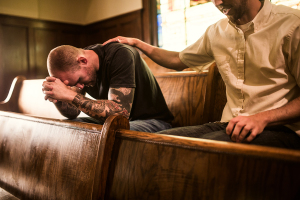No matter how you slice it, the resurrection of Jesus is a miracle
Whether you’re a Christian or atheist, if asked to explain the resurrection of Jesus Christ from the dead, your answer will always involve a miracle. Let me explain why.

First, long gone are the days when an educated person could get away with saying that Jesus was a mythical invention vs. historical person. The scholarly works of both non-Christians and believers alike put the final nail in that coffin long ago with a good summation coming from Princeton professor Bruce Metzger: “Today no competent scholar denies the historicity of Jesus.”[1]
Second, there is also agreement in the academic camps on the key historical facts of Jesus’ resurrection event, which are:
- Jesus was crucified and buried.
- Three days later, His body was reported missing by a group of His women followers and remains missing to this day.
- There were reported appearances of Jesus over the course of 40 or so days to both believers and unbelievers.
- People were transformed from these appearance events and publicly proclaimed Christ’s resurrection, with many being martyred for that proclamation.
Given this data isn’t in dispute, we’re left with the question of what cause best explains these details – which has the best explanatory power, scope, plausibility, and is less contrived than the others?
The non-Christian has basically two options[2] – both of which involve miracles – which for the sake of this article, we’ll define as a highly improbable, rare or extraordinary event with only naturalistic causes.
The biological miracle
The biological miracle option takes one of two forms. An example of the first occurred years ago during a debate between then-atheist Anthony Flew and Gary Habermas on the resurrection. Agreeing with the core resurrection facts above, Flew conceded that Jesus did actually rise from the dead, but insisted it was a one-time biological anomaly that never occurred before or since.
The second form of the biological miracle asserts that Jesus didn’t actually die, but rather those conducting His execution and burial falsely believed He was dead. Sometime after He was placed in the tomb, He revived, emerged, and presented Himself to His disciples as being raised from the dead.
Although an article published decades ago in the Journal of American Medical Association stated: “…interpretations based on the assumption that Jesus did not die on the cross appear to be at odds with modern medical knowledge"[3], this form of the biological miracle defense is still occasionally presented, although it wanes in popularity due to these reasons:
- The New Testament specifically records that Jesus was beaten and scourged before His crucifixion – a procedure that often greatly weakened and caused the death of many condemned persons before they ever reached their appointed cross.
- The Romans were experts at carrying out crucifixions. They knew death well; in fact, the soldiers themselves were held liable if any victim sentenced to death happened to survive.
- John 19:34-34 describes a spear being thrust into Jesus’ side, with the description by John clearly showing a rupture of the pericardium, which would be instant death if a casualty had not already occurred via the crucifixion procedure.
- Jesus’ death was viewed by close eyewitnesses, friend and foe alike.
- After He was taken from the cross, He was wrapped in cloths and bathed in heavy spices by loving friends who certainly would have noticed if He was still alive.
- Jesus would need to revive in the tomb, push back the huge stone covering the mouth of His grave, overpower the Roman guards sent to protect the tomb (Matt. 27:62-66), and then appear to His followers and skeptics – quite the task for a scourged and crucified man.
- The disciples’ reaction to a clearly disfigured and crucified Jesus would have been much different than the gospel accounts of Jesus’ resurrection.
Lastly, the biological miracle option paints a dark picture of Jesus’ moral character. Jesus would be much worse than just a liar. Not only would He have deliberately deceived His disciples, He would have remained in hiding while His disciples were arrested, tortured, and murdered for proclaiming His false resurrection.
The psychological miracle
Nearly every atheist who publicly debates a Christian apologist on the resurrection today turns to the psychological miracle option. An example is Richard Carrier who writes, “I believe the best explanation, consistent with both scientific findings and the surviving evidence . . . is that the first Christians experienced hallucinations of the risen Christ, of one form or another . . . In the ancient world, to experience supernatural manifestations of ghosts, gods, and wonders was not only accepted, but encouraged."[4]
However, when closely examined, the psychological miracle collapses under these critiques:
- If the tomb wasn’t empty, why didn’t Jesus’ enemies simply go to the tomb and display the body of Christ to squelch any resurrection talk? Instead, this option confirms an empty tomb and leads to the question of who stole the body and the widely debunked theft hypothesis option (i.e. the disciples stole the body).
- No hallucination experiences have ever been recorded like those depicted in this case. The appearances of Jesus are remarkable in that they occurred not just once, but multiple times; not just to one person, but to different persons; not just to individuals, but to groups of individuals; not just at one location, but at multiple locations; not just in one circumstance, but in multiple circumstances; not just to believers, but also to unbelievers, skeptics, and even enemies.
- All gospel accounts showcase the fact that the disciples did not expect Jesus to rise from the dead. Instead, they are portrayed as being dull to the teaching of Jesus on His predicted resurrection. This fact is highly significant in that it shows that they were not mentally building themselves up to believe that their murdered leader would appear to them alive.
- Standard Jewish belief only looked forward to a resurrection at the end of the world, with no one believing that anyone would be resurrected and remain alive before that appointed time (e.g. Dan. 12:2).
- Skeptics and enemies of Jesus – including disbelieving members of His own family – claimed to see Him alive after His crucifixion. From a psychological perspective, these individuals had no reason to mentally concoct a false appearance of a person they didn’t believe in from the start.
A theological miracle
With the unbeliever’s miraculous explanations for the resurrection being dismantled, we are left with one remaining choice: a theological miracle occurred. This differs from the naturalist’s miracle in that, while Christians agree a miracle is a highly improbable or extraordinary event, we add that it has divine origins, is performed by God for a distinct purpose, and always brings Him glory.
The theological miracle option simply claims the New Testament resurrection accounts are true. It eschews the anti-supernatural bias of naturalists in ruling God out in an a priori manner.
Including God in the equation automatically makes supernatural miracles possible as C. S. Lewis said: “But if we admit God, must we admit Miracle? Indeed, indeed, you have no security against it. That is the bargain."[5]
If an open vs. closed universe worldview is allowed, then when the accepted criteria of examining a historical account is used that includes explanatory power, explanatory scope, not being ad-hoc, plausibility, not contradicting accepted beliefs, and far exceeding its rival theories in meeting those conditions, the theological miracle emerges as the easiest option to accept.
This being the case, the rational person can hardly be blamed if he/she concludes on the basis of the evidence and a commitment to unbiased historiographical investigation that a divine miracle occurred on that first Easter morning.
Summing up this position, Dr. Thomas Arnold, the former chair of modern history at Oxford and author of the well-respected three volume “History of Rome”, says: “I have been used for many years to study the histories of other times, and to examine and weigh the evidence of those who have written about them, and I know of no one fact in the history of mankind which is proved by better and fuller evidence of every sort, to the understanding of a fair inquirer, than the great sign which God hath given us that Christ died and rose again from the dead.”[6]
[1] Bruce Metzger, The New Testament: Its Background, Growth, and Content (New York: Abingdon, 1965), pg. 78.
[2] Of course other hypotheses exist (e.g. theft hypothesis), but there is near universal agreement in them being discredited.
[3] “On the physical death of Jesus Christ”, Journal of American Medical Association, March 21, 1986.
[4] Richard Carrier, “The Spiritual Body of Christ” in The Empty Tomb, pg. 184.
[5] C. S. Lewis, Miracles, Harper Collins, 1974, pg. 169
[6] Arnold, Thomas. Sermons on the Christian Life - Its Hopes, Its Fears, Its Close, sixth edition, London: T. Fellowes, 1859, pg. 324.
Robin Schumacher is an accomplished software executive and Christian apologist who has written many articles, authored and contributed to several Christian books, appeared on nationally syndicated radio programs, and presented at apologetic events. He holds a BS in Business, Master's in Christian apologetics and a Ph.D. in New Testament. His latest book is, A Confident Faith: Winning people to Christ with the apologetics of the Apostle Paul.



























